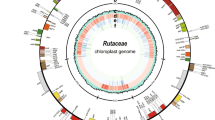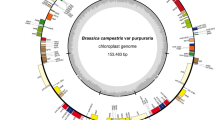Abstract
The uniparental inheritance and conserved structure of the chloroplast genome among many angiosperms makes it suitable for constructing gene lineages and inferring population histories based on these relationships. However, the analysis of a single chloroplast region to solve population issues has not yielded the desired amount of variability due to the low mutation rate. Therefore, it is necessary to screen and carefully analyze chloroplast intergenic or intronic regions to select the most appropriate for studying the genetic variability in the chloroplast genome of a particular taxon. In this context, the aim of this work was to characterize 8 regions in Calophyllum brasiliense using 11 selected primer pairs and to evaluate their usefulness for phylogeographic analysis. Intergenic spacers petA-psbJ, petG-trnP and rpl32-trnL and the trnL intron demonstrated potentially informative sites. The combination of these 4 regions will allow the analysis of genetic population structure and the integration of historical aspects to inform strategies for conserving C. brasiliense, especially for highly impacted populations and those at risk of local extinction.

Similar content being viewed by others
References
Carver T, Thomson N, Bleasby A, Berriman M, Parkhill J (2009) DNAPlotter: circular and linear interactive genome visualization. Bioinformatics 25:119–120
Chase MW, Cowan RS, Hollingsworth PM, van den Berg C, Madriñán S, Petersen G, Seberg O, Jørgsensen T, Cameron KM, Carine M, Pedersen N, Hedderson TAJ, Conrad F, Salazar GA, Richardson JE, Hollingsworth ML, Barraclough TG, Kelly L, Wilkinson M (2007) A proposal for a standardised protocol to barcode all land plants. Taxon 56:295–299
Demesure B, Sodzi N, Petit RJ (1995) A set of universal primers for amplification of polymorphic non-coding regions of mitochondrial and chloroplast DNA in plants. Mol Ecol 4:129–131
Dumoulin-Lapègue S, Demesure B, Fineschi S, Le Come V, Petit RJ (1997) Phylogeographic structure of white oaks throughout the European continent. Genetics 146:1475–1487
Gasparotto A Jr, Benzan MA, Piloto IC, Cortez DAZ (2005) Estudo fitoquímico da atividade moluscicida do Calophyllum brasiliense Camb. (Clusiaceae). Quim Nova 28:575–578
Hale ML, Squirrel J, Borland AM, Wolff K (2002) Isolation of polymorphic microsatellite loci in the genus Clusia (Clusiaceae). Mol Ecol Notes 2:506–508
Hale ML, Borland AM, Gustafsson MHG, Wolff K (2004) Causes of size homoplasy among chloroplast microsatellites in closely related Clusia sp. J Mol Evol 58:182–190
Hall TA (1999) BioEdit: a user-friendly biological sequence alignment editor and analysis program for Windows 95/98/NT. Nucleic Acids Symp Ser 41:95–98
Hamilton MB (1999) Four primer pairs for the amplification of chloroplast intergenic regions with intraspecific variation. Mol Ecol 8:513–525
Hollingsworth PM, Graham S, Little DP (2011) Choosing and using a plant DNA barcode. PLoS ONE 6:e19254
Huang S, Hwang S, Wang J, Lin T (2004) Phylogeography of Trochodendron aralioides (Trochodendraceae) in Taiwan and its adjacent areas. J Biogeogr 3:1251–1259
Kress WJ, Wurdack KJ, Zimmer EA, Weigt LA, Janzen DH (2005) Use of DNA barcodes to identify flowering plants. Proc Natl Acad Sci USA 102:8369–8374
Lihová J, Kudoh H, Marhold K (2010) Genetic structure and phylogeography of a temperate-boreal herb, Cardamine scutata (Brassicaceae), in northeast Asia inferred from AFLPs and cpDNA haplotypes. Am J Bot 97:1058–1070
Malé PG, Bardon L, Besnard G, Coissac C, Delsuc F, Engel J, Lhuillier E, Scotti-Saintagne C, Tinaut A, Chave J (2014) Genome skimming by shotgun sequencing helps resolve the phylogeny of a pantropical tree family. Mol Ecol Resour 14:966–975
Marques MC, Silva SM, Salino A (2003) Florística e estrutura do componente arbustivo-arbóreo de uma floresta higrófila da bacia do rio Jacaré-Pepira, SP, Brasil. Acta Bot Bras 17:495–506
Olmstead RG, Palmer JD (1994) Chloroplast DNA systematics: a review of methods and data analysis. Am J Bot 81:1205–1224
Palmer JD (1987) Chloroplast DNA and biosystematic uses of chloroplast DNA variation. Am Nat 130:S6–S29
Percuoco CB, Bich GA, Talavera Stéfani LN, Cardozo AE, Rodríguez ME, González NL, Sorol CB, Crivello JF, Crisci JV, Argüelles CF (2014) Assessment of genetic differentiation among relict populations of Calophyllum brasiliense Camb. (Calophyllaceae) from Northeast Argentina. J Biodivers Enviro Sci 5:87–98
Percuoco CB, Talavera Stéfani LN, Rodríguez ME, González NL, Crivello JF, Crisci JV, Argüelles CF (2015) Looking inside non-coding chloroplast regions of Calophyllum brasiliense (Calophyllaceae) to understand its southernmost population distribution. J Plant Sci 3(6):310–319
Petit RJ, Vendramin GG (2007) Plant phylogeography based on organelle genes: an introduction. In: Weiss S, Ferrand N (eds) Phylogeography of southern European refugia. Springer, Dordrecht, pp 23–97
Pires CTA, Brenzan MA, de Lima Scodro RB, Garcia Cortez DA, Dias Ghiraldi Lopes L, Dias Siqueira VL, Fressatti Cardoso R (2014) Anti-Mycobacterium tuberculosis activity and cytotoxicity of Calophyllum brasiliense Cambess. (Clusiaceae). Mem Inst Oswaldo Cruz 109:324–329
Ramos ACS, Lemos-Filho JP, Ribeiro RA, Santos FR, Lovato MB (2007) Phylogeography of the tree Hymenaea stigonocarpa (Fabaceae: caesalpinioideae) and the influence of Quaternary climate changes in the Brazilian Cerrado. Ann Bot 100:1219–1228
Rea A, Tempone AG, Pinto EG, Mesquita JT, Rodrigues E, Grus M, Silva L, Sartorelli P, Lago JHG (2013) Soulamarin isolated from Calophyllum brasiliense (Clusiaceae) induces plasma membrane permeabilization of Trypanosoma cruzi and mytochondrial dysfunction. PLoS Negl Trop Dis 7:e2556. doi:10.1371/journal.pntd.0002556
Reitz R, Klein RM (1978) Projeto madeira de Santa Catarina. Sellowia 30:28–30
Rodríguez ME, Cardozo A, Krauczuk E, Fontana J, Iriart Y (2009) Calophyllum brasiliense (CLUSIACEAE) nuevo registro para la flora de la Argentina. Bol Soc Argent Bot 44:361–366
Salgueiro F, Neri J, Alves-Ferreira M, Scarano F (2011) Phylogeographic patterns of Calophyllum brasiliense Camb. (Calophyllaceae) based on the psbA-trnH cpDNA locus. BMC Proc 5(7):17
Shaw J, Lickey EB, Beck JT, Farmer SB, Liu W, Miller J, Siripun KC, Winder CT, SchillingEE Small RL (2005) The tortoise and the hare II: relative utility of 21 noncoding chloroplast DNA sequences for phylogenetic analysis. Am J Bot 92:142–166
Shaw J, Lickey EB, Schilling EE, Small RL (2007) Comparison of whole chloroplast genome sequences to choose noncoding regions for phylogenetic studies in angiosperms: the tortoise and the hare III. Am J Bot 94:275–288
Shaw J, Shafer HL, Leonard OR, Kovach MJ, Schorr M, Morris AB (2014) Chloroplast DNA sequence utility for the lowest phylogenetic and phylogeographic inferences in angiosperms: the tortoise and the hare IV. Am J Bot 101:1987–2004
Stange C, Prehn D, Arce-Johnson P (1998) Isolation of Pinus radiate genomic DNA suitable for RAPD analysis. Plant Mol Biol Rep 1:1–8
Taberlet P, Gielly L, Pautou G, Bouvet J (1991) Universal primers for amplifications of three non-coding regions of chloroplast DNA. Plant Mol Biol 17:1105–1109
Taberlet P, Coissac E, Pompanon F, Gielly L, Miquel C, Valentini A, Vermat T, Corthier G, Brochmann C, Willerslev E (2007) Power and limitations of the chloroplast trnL (UAA) intron for plant DNA barcoding. NuclAcids Res 35:e14
Weising K, Gardner R (1999) A set of conserved PCR primers for the analysis of simple sequence repeat polymorphisms in chloroplast genomes of dicotyledonous angiosperms. Genome 42:9–19
Zheng Z, Schwartz L, Wagner L, Miller W (2000) A greedy algorithm for aligning DNA sequence. J Comput Biol 7:203–214
Acknowledgements
The present work was partially supported by Consejo de Investigación y Desarrollo Tecnológico (CIDET Project 16Q409 to C.F.A.) and Fondo para la Investigación Científica y Tecnológica Project (PICTO UNaM 2011 N°122 to C.F.A.). We also thank the Consejo Nacional de Investigaciones Científicas y Técnicas (CONICET) for providing postgraduate fellowships to C.B.P. and L.N.T.S. and the Comité Ejecutivo de Desarrollo e Innovación Tecnológica (CEDIT) for the research fellowship to L.G.G. and L.N.T.S. and the Consejo Interuniversitario Nacional (CIN) for the fellowship to L.N.T.S.
Author information
Authors and Affiliations
Corresponding author
Additional information
Project funding: The present work was partially supported by Consejo de Investigación y Desarrollo Tecnológico (CIDET Project 16Q409 to C.F.A.) and Fondo para la Investigación Científica y Tecnológica Project (PICTO UNaM 2011 No. 122 to C.F.A).
The online version is available at http://www.springerlink.com
Corresponding editor: Chai Ruihai.
Rights and permissions
About this article
Cite this article
Percuoco, C.B., Giménez, L.G., Talavera Stéfani, L.N. et al. Screening chloroplast regions in Calophyllum brasiliense (Calophyllaceae) for suitability for population genetic analyses. J. For. Res. 29, 983–990 (2018). https://doi.org/10.1007/s11676-017-0489-1
Received:
Accepted:
Published:
Issue Date:
DOI: https://doi.org/10.1007/s11676-017-0489-1




